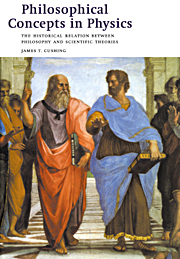 Philosophical Concepts in Physics
Philosophical Concepts in Physics Book contents
- Frontmatter
- Contents
- Preface
- Copyright acknowledgments
- PART I The scientific enterprise
- PART II Ancient and modern models of the universe
- PART III The Newtonian universe
- PART IV A perspective
- 10 Galileo's Letter to the Grand Duchess
- 11 An overarching Newtonian framework
- 12 A view of the world based on science: determinism
- PART V Mechanical versus electrodynamical world views
- PART VI The theory of relativity
- PART VII The quantum world and the completeness of quantum mechanics
- PART VIII Some philosophical lessons from quantum mechanics
- PART IX A retrospective
- Notes
- General references
- Bibliography
- Author index
- Subject index
10 - Galileo's Letter to the Grand Duchess
Published online by Cambridge University Press: 05 June 2012
- Frontmatter
- Contents
- Preface
- Copyright acknowledgments
- PART I The scientific enterprise
- PART II Ancient and modern models of the universe
- PART III The Newtonian universe
- PART IV A perspective
- 10 Galileo's Letter to the Grand Duchess
- 11 An overarching Newtonian framework
- 12 A view of the world based on science: determinism
- PART V Mechanical versus electrodynamical world views
- PART VI The theory of relativity
- PART VII The quantum world and the completeness of quantum mechanics
- PART VIII Some philosophical lessons from quantum mechanics
- PART IX A retrospective
- Notes
- General references
- Bibliography
- Author index
- Subject index
Summary
In this chapter we study one of the dramatic clashes that took place during the overthrow of the Aristotelian world view that had given man a unified picture of himself and of his surroundings. In the Galileo episode this became hopelessly entangled with the issue of intellectual freedom versus institutional authority. However, there were other relevant factors as well: the personalities of Galileo and of those who opposed him and, possibly, the social structure of the patronage system of support for artists and scientists in those times.
THE BACKGROUND
Perhaps it will help the reader if we begin by listing several key events that preceded the direct confrontation between Galileo and the Church authorities.
March 1610 – Galileo published the Sidereus Nuncius (The Starry Messenger) in which he discussed his telescopic observations and discoveries. He showed that there were many more stars in the heavens than had been thought previously, that the surface of the moon was rough, containing mountains, plains and valleys, much like the surface of the earth itself, and that Jupiter had a set of moons orbiting the central planet, very much as the planets orbit the sun in the Copernican system. This work had great popular appeal and wide impact.
December 1613 – Galileo wrote a letter to one of his scientific pupils, the Benedictine monk Benedetto Castelli (1578–1643), concerning his own views on the relation between science and religion.
[…]
- Type
- Chapter
- Information
- Philosophical Concepts in PhysicsThe Historical Relation between Philosophy and Scientific Theories, pp. 135 - 147Publisher: Cambridge University PressPrint publication year: 1998
